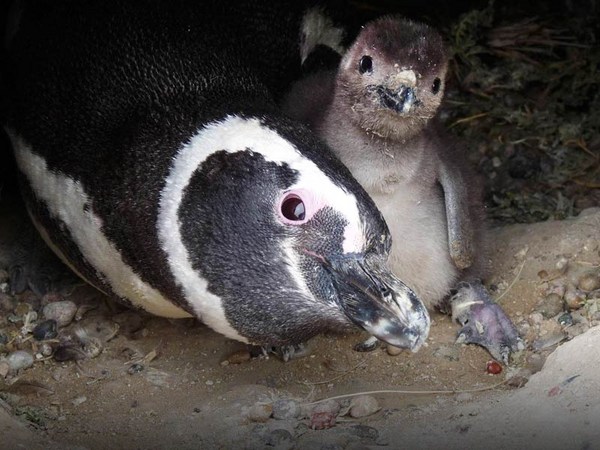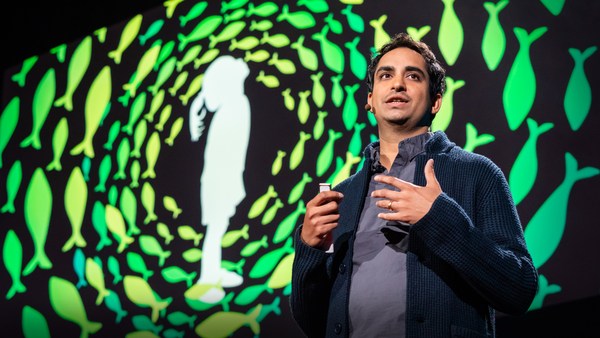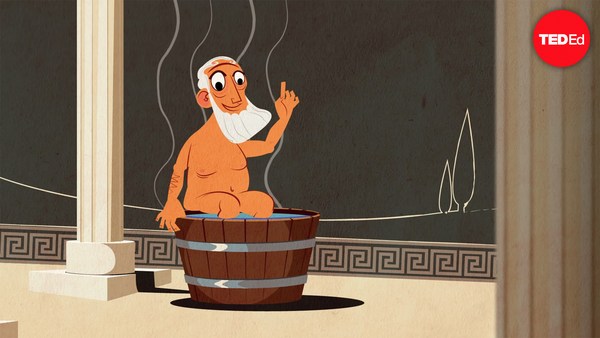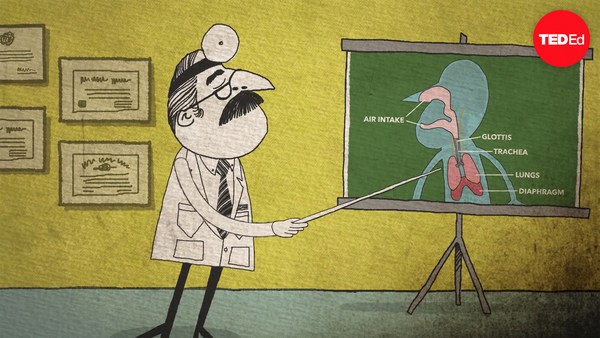Some years ago, I was visiting Paris and walking along the Seine River during a beautiful summer afternoon. I saw giant bubbles floating on the riverbank, like this one. The next moment, it popped and was gone. Making them were two street performers surrounded by a crowd. They visibly make a living by asking for donations and by selling pairs of sticks tied with two strings. When I was there, a man bought a pair of sticks for 10 euros, which surprised me. I am a scientist who is passionate about bubbles. I know the right trick to make the giant bubbles is the right soapy water mixture itself -- not the sticks, which may be needed, but you can easily make them at home. Focusing on the sticks makes us not see that the real tool is the bubble itself.
Bubbles might seem like something just children make while playing, but sometimes it can be really stunning. However, there are more fascinating science to bubbles, such as problem-solving tools. So I would like to share with you a few stories about the science of creating bubbles and the science of eliminating the microscopic ones.
Since it's up on the screen, let's start with the soap bubble. It is made from very common substances: air, water, soap, in the right mixture. You can see soap bubbles constantly changing their colors. This is due to the interaction with light at various directions and the changes of their thickness. One of the common substances, water molecules, are formed by two atoms of hydrogen and one atom of oxygen -- H2O. On most surfaces, water droplets tend to curve inwards, forming a semihemisphere shape. This is because the water droplet's surface is like an elastic sheet. The water molecule on the surface is constantly being pulled inwards by the molecule at the center. And the quality of the elasticity is what we call "surface tension." Now by adding soap, what happens is the soap molecule reduces the surface tension of water, making it more elastic and easier to form bubbles. You can think of a bubble as a mathematical problem-solver. You see it relentlessly trying to achieve geometry perfection. For instance, a sphere is the shape with the least surface area for a given volume. That's why a single bubble is always in the shape of a sphere. Let me show you. Check it out.
This is a single bubble. When two bubbles touch each other, they can save materials by sharing a common wall. When more and more bubbles are added together, their geometry changes. These four bubbles are added together. They meet at one point at the center.
When six bubbles are added together, a magical cube appears at the center.
(Applause)
That is surface tension at work, trying to find the most effective geometry arrangement.
Now, let me give you another example. This is a very simple prop. This is made from two layers of plastic with four pins connected to each other. Imagine these four pins represent four cities that are equally apart, and we would like to make roads to connect these four cities. My question is: What is the shortest length to connect these four cities? Let's find out the answer by dipping it into the soapy water. Remember, the soap bubble forms will always try to minimize their surface area with a perfect geometry arrangement. So the solution might not be something you expected. The shortest length to connect these four cities is 2.73 times the distance between these two cities.
(Applause)
Now you've got the idea. The soap bubble forms will always try to minimize their surface area with a perfect geometry arrangement.
Now, let us look at bubbles in another perspective. My daughter, Zoe, loves visiting zoos. Her favorite spot is Penguin Cove at Marwell Zoo in Southern England, where she could see penguins swim at speed under the water. One day, she noticed that the body of penguins leaves a trail of bubbles when they swim and asked why. Animals and birds like penguins that spend a lot of their time under the water have evolved an ingenious way of utilizing the capability of bubbles to reduce the density of water. Emperor penguins are thought to be able to dive a few hundred meters below the sea surface. They are thought to store the air under their feathers before they dive and then progressively release it as a cloud of bubbles. This reduces the density of water surrounding them, making it easier to swim through and speed up their swimming speed at least 40 percent.
This feature has been noticed by the ship manufacturers. I am talking about the big ships here, the ones that are used to transport thousands of containers across the ocean. Recently, they developed a system called "air lubricating system," inspired by the penguins. In this system, they produce a lot of air bubbles and redistribute them across the whole of the ship, like an air carpet that reduces the water resistance when a ship is moving. This feature cuts off the energy consumption for the ship up to 15 percent.
Bubbles can also be used for medicines. It can also play a role in medicines, for instance, as a method for noninvasive delivery systems for drugs and genes to a specific part of the body. Imagine a microbubble filled with a mixture of drugs and magnetic agents being injected into our bloodstream. The bubbles will move to the target areas. But how do they know where to go? Because we placed a magnet there. For instance, this part of my hand. When the microbubbles move to this part of my hand, we can pop it via ultrasound and release the drug exactly where it's needed.
Now, I mentioned about the science of creating bubbles. But sometimes we also need to remove them. That's actually part of my job. My exact job title is "ink formulation scientist." But I don't work on the ink that you use for your writing pens. I'm working on some cool applications such as organic photovoltaics, OPVs, and organic light-emitting diodes, OLEDs. Part of my job is to figure out how and why we want to remove the bubbles from the ink that my company produces. During the formulation-mixing process, or preparation process, we mix active ingredients, solvents and additives in order to achieve the formulations with the properties we want when the ink is being used.
But just like you would make drinks or bake cakes, it is unavoidable that some air bubbles will be trapped inside that ink. Here, we are talking about a different space from the bubbles I'd seen in Paris. The bubbles that are trapped inside those inks vary between a few millimeters, a few microns or even a few nanometers in size. And what we are concerned about is the oxygen and the moisture that is trapped inside. At this size scale, removing them is not easy. But it matters, for instance, for organic light-emitting diodes inks that we can use to produce display for your smartphone, for example. It's supposed to last for many years, but if the ink that we use has been absorbed with oxygen and moisture [which] are not being removed, then we can quickly see dark spots appear in the pixels.
Now, one challenge we face in removing the microbubbles is that they are not very cooperative. They like to sit there, bathing in the ink without moving much. But how do we kick them out? One technology we use is to force the ink going through a thin, long and tiny tube with a porous wall, and we place the tubes inside the vacuum chamber, so that the bubbles can be squeezed out from the ink and be removed.
Once we manage to remove the bubbles from the ink that we produce, it is time for celebration. Let's open a bubbling champagne. Ooh, this is going to be fun!
(Laughter)
Woooo!
(Applause)
You could see a lot of bubbles rushing out from the champagne bottle. These are the bubbles filled with carbon dioxide, a gas that's been produced during the fermentation process of the wine. Let me pour some out. I can't miss the chance. I guess it's enough.
(Laughter)
Here, I can see a lot of microbubbles moving from the bottom of the glass to the top of the champagne. Before it pops, it will jet tiny droplets of aroma molecules and intensify the flavor of champagne, making us enjoy much more the flavor of champagne.
As a scientist who is passionate about bubbles, I love to see them, I love to play with them, and I love to study them. And also, I love to drink them.
Thank you.
(Applause)





